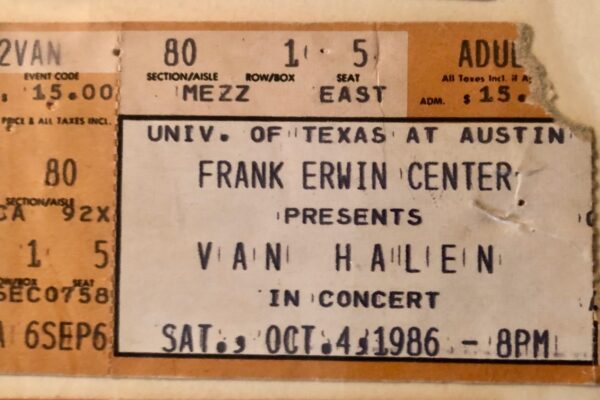You might have noticed that a very large, distinctively shaped structure at I-35 and MLK Blvd. in Austin is slowly disappearing. It is, of course, the Erwin Center, which for more than 40 years anchored the southeast corner of the Forty Acres.
The Drum, as it was known for an obvious reason, hosted the Harlem Globetrotters, its last ticketed event, on April 2, 2022. The Moody Center, UT’s new arena, opened just more than two weeks later. A month later, college commencement ceremonies were held in the Erwin Center, and that was a wrap. Demolition began last November in phases to preserve nearby structures and to recycle as much material as is feasible. By October 2024, it should be gone, and something even bigger will take its place soon thereafter.
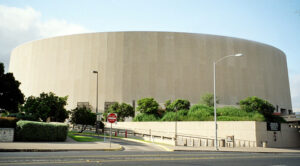
The first time I ever saw the Erwin Center was March 17, 1984. I was a junior in high school and had been invited to Austin for spring break by a friend and his family. The centerpiece of our trip was a concert by the band Yes. The strange, humongous structure, like a UFO whose alien builders had gotten carried away, loomed over I-35 and signaled, more so than even the distant Tower, that travelers had reached The University of Texas at Austin.
When we got inside, the cavernous space went dark, and the opening chords of “Owner of a Lonely Heart,” with accompanying green lasers, signaled a new chapter in my adolescence, the experience of big-time rock shows.
It’s hard to believe that at that point it had only been open six years, as it seemed so grand and permanent that it must have always been there. But indeed it had been completed in 1977 for $34 million. The Texas men’s basketball team opened the “Special Events Center” on November 29, 1977 (an 83–76 victory over OU, just to say).
As a college student, as a UT staffer, as a Longhorn fan, as a dad, the Erwin Center was always there."
It did not become the “Frank Erwin Center” until 1980, the year its namesake, perhaps the most influential regent of the modern era, died. The Erwin Center was a marvel of its age, second only to the Astrodome for indoor entertainment spaces in Texas. It required 5,000 tons of steel, in contrast to the 800 tons that had been required by the building whose functions it was assuming, Gregory Gym.
The “Super Drum,” as it was called during construction, was also notable for its upholstered seats and its scoreboard, a whopping 19 feet square, which, for something that is merely a scoreboard is probably big enough. By contrast, the new Moody Center’s “video display system” is 20.5’ x 27’ (not to be confused with DKR’s video screen, which measures more than 56’ x 134’; at Texas, we really like to know what the score is). “The new facility is magnificent,” wrote Austin American-Statesman columnist Jim Trotter in 1977 of the 16,540-seat arena, “a testament to what $30 million and pocket change can do.”
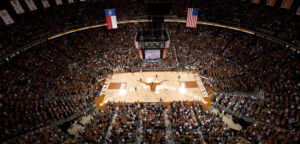
For much of my existence since that Yes concert, that building, whose functions — academic, entertaining and sporting — are now performed by the state-of-the-art Moody Center just to its north, dropped in and out of my life like a recurring character in a TV series. As a college student, as a UT staffer, as a Longhorn fan, as a dad, the Erwin Center was always there.
For starters, the arena provided a banging soundtrack to my student days in the late 1980s. Betraying both my age and my cultural milieu, I bore witness to shows by Rush, Foreigner, Ozzy Osbourne, Journey, Boston, Chicago, Triumph and others. I saw Metallica as an opening act — that’s how long ago it was. I vividly recall the 1986 Van Halen concert during which Sammy Hagar stood on the railing of a catwalk 50 feet over the audience, unsecured, and holding a steel cable with one hand leaned out over the abyss. Those tickets, many of which I have kept, sold from $13.50 to a staggering $16. (#InMyDay!)
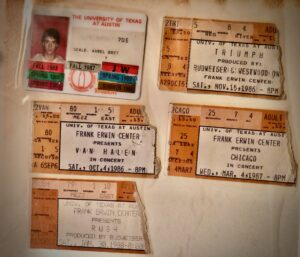
Erwin Center tickets and my student I.D., scrapbook-worthy relics of my deafening youth
Admittedly, not all memories of the Erwin Center evoke dreamy smiles of nostalgia. One case in point was the semesterly ordeal of adds and drops. Lines of students, many sitting on the floor to conserve energy, snaked across and along the circular lobby, as staffers behind folding tables did their best to accommodate our requests at a University that was bursting at the seams. As I wrote in The Alcalde in 1998:
“It was one of those rare scenes in life where the architecture of your surroundings matches the situation perfectly, and even augments it — the lobby going around and around and around, nightmare-like, without beginning or end, without linear logic. It was a metaphor for our conversations with longsuffering department staffers:
“But I need this class?”
“Right.”
“But I can’t take this class?”
“Right.”
“But I need this class.”
“Right.”
The memory of adds and drops surely will temper the pangs of nostalgia I otherwise would feel when the last truckload of rubble is hauled away from 1701 Red River Street.
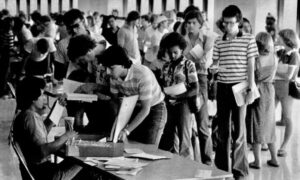
As student days drew to a close, the Erwin Center became the site of my college graduation, my parents and brothers watching from the lower “arena” seating section, an endless loop of “Pomp and Circumstance” piped through the PA as I made my way across the dais and shook hands with the Communications dean. It has hosted many a local high school commencement too.
When I returned to campus as a young journalist covering the University, I attended talks in the arena, including by the Dalai Lama and President Clinton. I remember the dedication of a statue of women’s basketball coach and athletics director Jody Conradt (whom the building probably would have been named for had the timing been slightly different), a football players end-of-season banquet, and the memorial service for Darrell Royal — Willie Nelson and Trigger providing the music.
As I became a father, the Erwin Center became the site of numerous Harlem Globetrotters games in addition to the Runnin’ Horns, just as for other parents it had offered up Muppets on Ice or the Ringling Bros. and Barnum & Bailey Circus — elephants parading from their railroad stop at 4th Street north through downtown to their temporary home in the Erwin Center parking lot.
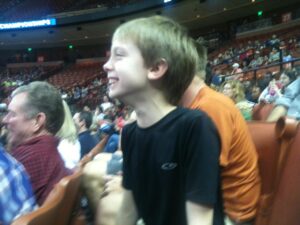
By 2000, it was showing its age, and between 2001 to 2003, $55 million was spent renovating seating and installing new video and sound systems, and lighting, as well as building 28 suites. The concerts continued into adulthood, with more Boston and more Rush, but adding mellower fare such as James Taylor. But the march of technology, the demands of touring shows, and the University’s desire to have the best was the writing on the circular wall. Even the Astrodome, once called a modern wonder of the world, has long been replaced (though not demolished due to environmental concerns).
So what will sit on the Erwin Center’s massive footprint? The first new components of the UT Austin Medical Center, established last year. Two hospital towers will be built on the site: the UT MD Anderson Cancer Center and a yet-to-be-named specialty hospital built and operated by UT.
As I ponder all of that, I think of how this space is entering a new phase in which it will make possible, for thousands of people into the future, the sort of life-enriching moments that the Erwin Center hosted for me. A baby in need of heart surgery will survive and grow up to perhaps attend his very first big-time concert across the street. A teenager will beat cancer and go on to attend a university, perhaps this one, and maybe they’ll study to be a doctor or nurse and make their rounds on this plot of land. A young man will be admitted to the hospital for a complicated condition and because of these hospitals will survive it. He’ll have kids and get to see the smile on their faces when he takes them to their first Harlem Globetrotters game, in which the Globetrotters will eke out a last-minute victory over the longsuffering Washington Generals. Great buildings may come and go, but that is something that will never, ever change.
Big, unique and audacious, the Drum was on brand in every way for this growing University and its surrounding city. Let it be thus remembered, and let us look forward to what’s coming.

